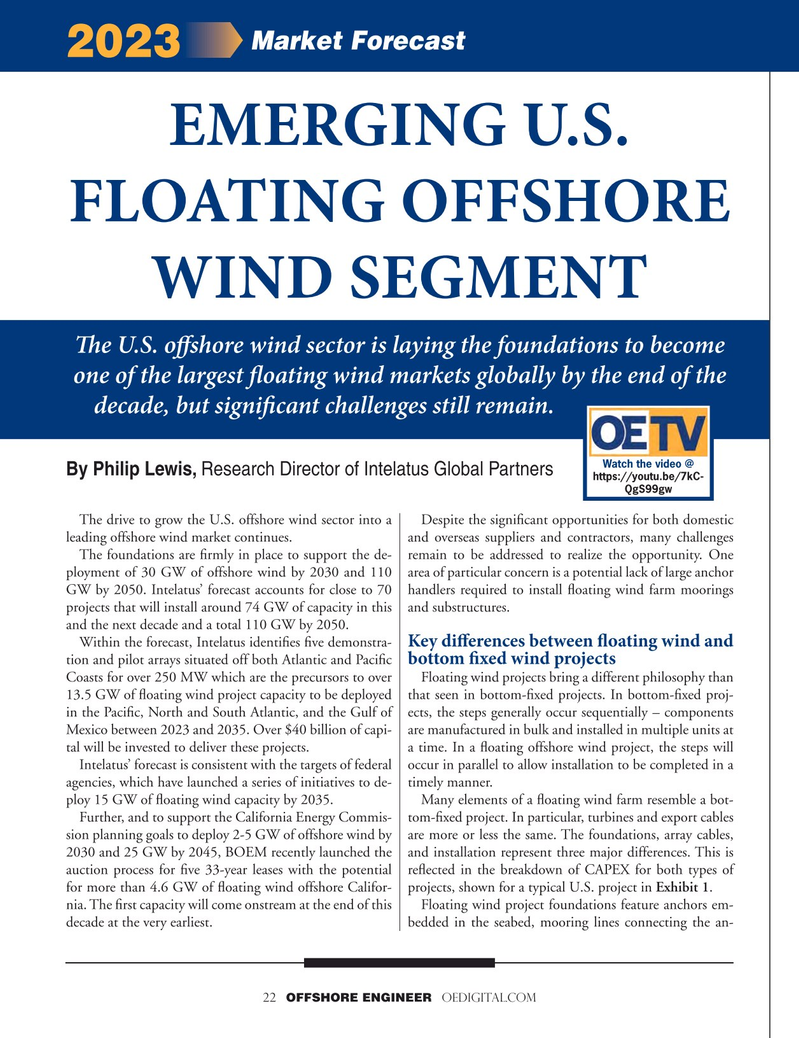
Page 22: of Offshore Engineer Magazine (Nov/Dec 2022)
Read this page in Pdf, Flash or Html5 edition of Nov/Dec 2022 Offshore Engineer Magazine
Market Forecast 2023
EMERGING U.S.
FLOATING OFFSHORE
WIND SEGMENT
Te U.S. ofshore wind sector is laying the foundations to become one of the largest foating wind markets globally by the end of the decade, but signifcant challenges still remain.
Watch the video @
By Philip Lewis, Research Director of Intelatus Global Partners https://youtu.be/7kC-
QgS99gw
The drive to grow the U.S. offshore wind sector into a Despite the signi?cant opportunities for both domestic leading offshore wind market continues. and overseas suppliers and contractors, many challenges
The foundations are ?rmly in place to support the de- remain to be addressed to realize the opportunity. One ployment of 30 GW of offshore wind by 2030 and 110 area of particular concern is a potential lack of large anchor
GW by 2050. Intelatus’ forecast accounts for close to 70 handlers required to install ?oating wind farm moorings projects that will install around 74 GW of capacity in this and substructures.
and the next decade and a total 110 GW by 2050.
Within the forecast, Intelatus identi?es ?ve demonstra-
Key diferences between foating wind and tion and pilot arrays situated off both Atlantic and Paci?c bottom fxed wind projects
Coasts for over 250 MW which are the precursors to over Floating wind projects bring a different philosophy than 13.5 GW of ?oating wind project capacity to be deployed that seen in bottom-?xed projects. In bottom-?xed proj- in the Paci?c, North and South Atlantic, and the Gulf of ects, the steps generally occur sequentially – components
Mexico between 2023 and 2035. Over $40 billion of capi- are manufactured in bulk and installed in multiple units at tal will be invested to deliver these projects. a time. In a ?oating offshore wind project, the steps will
Intelatus’ forecast is consistent with the targets of federal occur in parallel to allow installation to be completed in a agencies, which have launched a series of initiatives to de- timely manner. ploy 15 GW of ?oating wind capacity by 2035. Many elements of a ?oating wind farm resemble a bot-
Further, and to support the California Energy Commis- tom-?xed project. In particular, turbines and export cables sion planning goals to deploy 2-5 GW of offshore wind by are more or less the same. The foundations, array cables, 2030 and 25 GW by 2045, BOEM recently launched the and installation represent three major differences. This is auction process for ?ve 33-year leases with the potential re?ected in the breakdown of CAPEX for both types of for more than 4.6 GW of ?oating wind offshore Califor- projects, shown for a typical U.S. project in Exhibit 1.
nia. The ?rst capacity will come onstream at the end of this Floating wind project foundations feature anchors em- decade at the very earliest. bedded in the seabed, mooring lines connecting the an- 22 OFFSHORE ENGINEER OEDIGITAL.COM

 21
21

 23
23